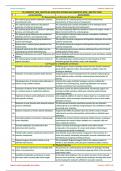Ketone - Study guides, Revision notes & Summaries
Looking for the best study guides, study notes and summaries about Ketone? On this page you'll find 2850 study documents about Ketone.
Page 3 out of 2.850 results
Sort by

-
SCI 225 Week 16 Pathophysiology Final Exam Proctored-Nightingale College.
- Exam (elaborations) • 26 pages • 2022
-
- £8.99
- 2x sold
- + learn more
SCI 225 Week 16 Pathophysiology Final Exam Proctored-Nightingale College. Question 1 1 / 1 pts A patient with type 1 diabetes asks the nurse what causes polyuria. What is the nurse’s best response? The symptom of polyuria in diabetes mellitus (DM) is caused by: a reduced ADH response caused by insulin deficiency. the loss of protein across the glomerular membrane. the production of ketones. increased glucose in the urine. The presence of glucose in the urine filtrate d...
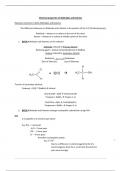
-
Chemical properties of Aldehydes and Ketones
- Exam (elaborations) • 45 pages • 2024
-
- £10.22
- + learn more
Chemical properties of Aldehydes and Ketones Reactions common to both Aldehydes and Ketones The difference between an Aldehyde and a Ketone is the position of the C=O (Carbonyl group). Aldehyde – always on a carbon at the end of the chain Ketone – Always on a carbon at middle carbon of the chain 1. BOTH Aldehydes and Ketones can be reduced Aldehyde reduced to Primary Alcohol Reducing agent = Sodium tetrahydroborate III (NaBH4) Ketone reduced to Secondary Alcohol Reduction Oxidisatio...
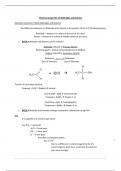
-
Chemical properties of Aldehydes and Ketones
- Exam (elaborations) • 45 pages • 2024
-
- £8.99
- + learn more
Chemical properties of Aldehydes and Ketones Reactions common to both Aldehydes and Ketones The difference between an Aldehyde and a Ketone is the position of the C=O (Carbonyl group). Aldehyde – always on a carbon at the end of the chain Ketone – Always on a carbon at middle carbon of the chain 1. BOTH Aldehydes and Ketones can be reduced Aldehyde reduced to Primary Alcohol Reducing agent = Sodium tetrahydroborate III (NaBH4) Ketone reduced to Secondary Alcohol Reduction Oxidisation ...
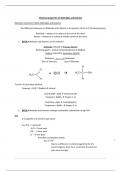
-
Chemical properties of Aldehydes and Ketones Reactions common to both Aldehydes and Ketones
- Exam (elaborations) • 45 pages • 2024
-
- £9.40
- + learn more
Chemical properties of Aldehydes and Ketones Reactions common to both Aldehydes and Ketones The difference between an Aldehyde and a Ketone is the position of the C=O (Carbonyl group). Aldehyde – always on a carbon at the end of the chain Ketone – Always on a carbon at middle carbon of the chain 1. BOTH Aldehydes and Ketones can be reduced Aldehyde reduced to Primary Alcohol Reducing agent = Sodium tetrahydroborate III (NaBH4) Ketone reduced to Secondary Alcohol Reduction Oxidisatio...
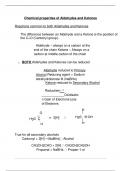
-
Chemical properties of Aldehydes and Ketones
- Exam (elaborations) • 83 pages • 2024
-
- £10.22
- + learn more
Chemical properties of Aldehydes and Ketones in of Electrons Loss of Electrons H O H3C C H + 2[H] H3C C OH H True for all secondary alcohols Carbonyl + 2[H] ─(NaBH4) Alcohol CH3CH2CHO + 2[H] CH3CH2CH2OH Propanal + NaBH4 Propan-1-ol
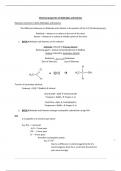
-
Chemical properties of Aldehydes and Ketones
- Exam (elaborations) • 45 pages • 2024
-
- £14.72
- + learn more
Chemical properties of Aldehydes and Ketones Reactions common to both Aldehydes and Ketones The difference between an Aldehyde and a Ketone is the position of the C=O (Carbonyl group). Aldehyde – always on a carbon at the end of the chain Ketone – Always on a carbon at middle carbon of the chain 1. BOTH Aldehydes and Ketones can be reduced Aldehyde reduced to Primary Alcohol Reducing agent = Sodium tetrahydroborate III (NaBH4) Ketone reduced to Secondary Alcohol Reduction Oxidisatio...
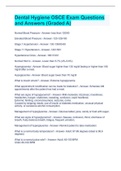
-
Dental Hygiene OSCE Exam Questions and Answers (Graded A)
- Exam (elaborations) • 6 pages • 2023
-
- £9.40
- 8x sold
- + learn more
Normal Blood Pressure - Answer- less than 120/80 Elevated Blood Pressure - Answer- 120-129/<80 Stage 1 Hypertension - Answer- 130-139/80-89 Stage 11 Hypertension - Answer- 140+/90+ Hypertensive Crisis - Answer- 180+/120+ Normal HbA1c - Answer- Lower than 5.7% (4%-5.6%) Hyperglycemia - Answer- Blood sugar higher than 130 mg/dl fasting or higher than 180 mg/dl after a meal. Hypoglycemia - Answer- Blood sugar lower than 70 mg/dl What is insulin shock? - Answer- Extreme hy...

-
NURS 5315 Advanced Pathophysiology Exam 1 Questions with Verified Answers |Latest 2024/2025
- Exam (elaborations) • 23 pages • 2024
- Available in package deal
-
- £8.99
- + learn more
What is the body's defense against ROS? Antioxidants (Vitamin E, Vitamin C, cysteine, glutathione, albumin, ceruloplasmin, transferrin) How does a hypertonic solution alter osmolality? Increases solute concentration, causing INCREASED osmolality. Causes cells to SHRINK. What lab values are elevated as we age? Interleukin 1, tumor necrosis factor-alpha, and C-reactive protein Role of hepatocytes Acetyl CoA is processed by hepatocytes and transforms to 3 ketone bodies: 1. Acetoa...

-
Solution Manual for Organic Chemistry Mechanistic Patterns Canadian 1st Edition by Ogilvie Ackroyd Br
- Exam (elaborations) • 811 pages • 2024
-
- £16.36
- 1x sold
- + learn more
Chapter 1 Carbon and Its Compounds CHECKPOINT PROBLEMS Practice Problem 1.1 a) S — 1s2 2s2 2p6 3s2 3p4 b) Cl — 1s2 2s2 2p6 3s2 3p5 c) Na+ — 1s2 2s2 2p6 1-2 Copyright © 2018 Nelson Education Limited Practice Problem 1.2 a) Count valence electrons. Build a basic bonding framework and account for electrons used. Add remaining electrons and check for formal charges. The molecule has a lone pair on the nitrogen. All other electrons are bonding electrons. b) Count valence electrons. Build a bas...
XII_Chem_New_Chap_08_Aldehydes,_Ketones_and_Carboxylic_Acids_137

How did he do that? By selling his revision notes on Stuvia. Try it yourself! Discover all about earning on Stuvia



